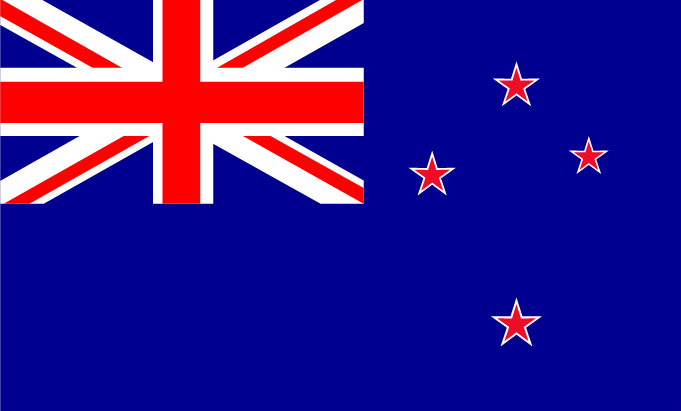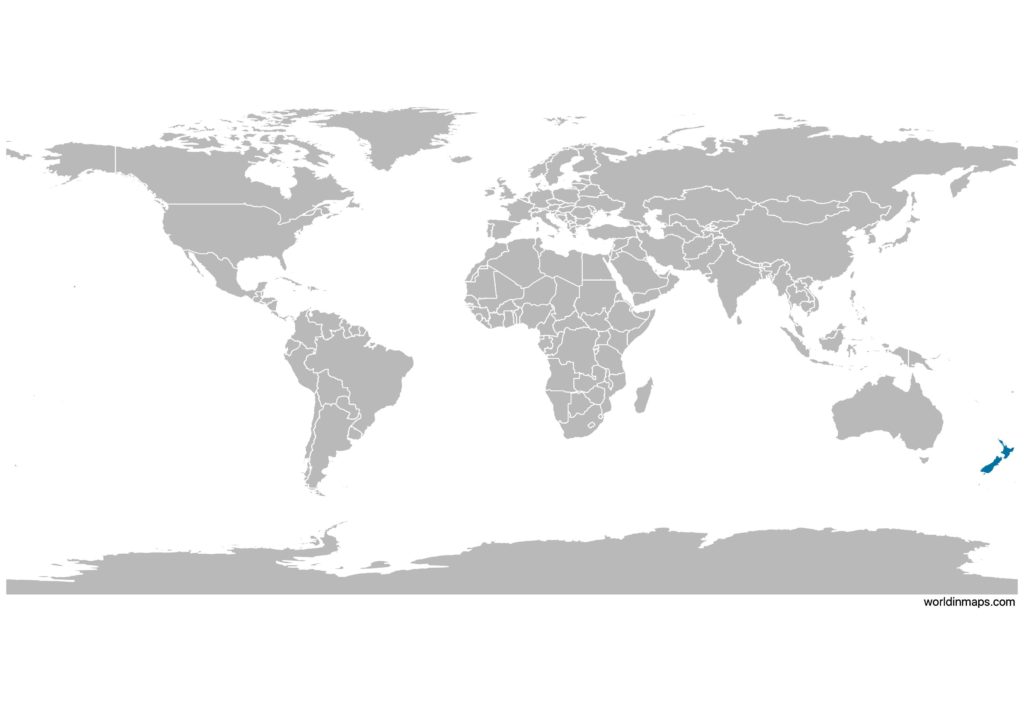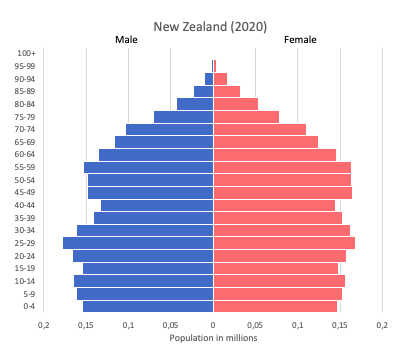New Zealand

| Government | |
| Name | New Zealand |
| Māori | Aotearoa |
| Government type | parliamentary democracy under a constitutional monarchy (a Commonwealth realm) |
| Capital | Wellington (215,400 (2018)) |
| Currency | New Zealand dollar (NZD) |
| Organization | |
| Member State | Commonwealth of Nations |
| People | |
| Population (2020) | 4,822,233 (120th) |
| Density of population | 18.3 P/km2 (167th) |
| Nationality | New Zealander |
| Official languages | |
| English | |
| Maori | |
| New Zealand Sign Language | |
| Ethnic groups (2018) | |
| European | 64.1% |
| Maori | 16.5% |
| Chinese | 4.9% |
| Indian | 4.7% |
| Samoan | 3.9% |
| Tongan | 1.8% |
| Cook Islands Maori | 1.7% |
| English | 1.5% |
| Filipino | 1.5% |
| New Zealander | 1% |
| other | 13.7% |
| percentages add up to more than 100% because respondents were able to identify more than one ethnic group | |
| Religions (2018) | |
| Christian | 37.3% |
| Catholic | 10.1% |
| Anglican | 6.8% |
| Presbyterian and Congregational | 5.2% |
| Pentecostal | 1.8% |
| Methodist | 1.6% |
| Mormon | 1.2% |
| other | 10.7% |
| Hindu | 2.7% |
| Maori | 1.3% |
| Muslim | 1.3% |
| Buddhist | 1.1% |
| other religion | 1.6% |
| no religion | 48.6% |
| objected to answering | 6.7% |
| percentages add up to more than 100% because respondents were able to identify more than one religion | |
| Life expectancy (2020) | |
| Male | 80.4 years |
| Female | 84 years |
| Total population | 82.1 years (22nd) |
| Homicides | |
| Total (2017) | 0.7 per 100,000 people (150th) |
| Geography | |
| Land area | 264,537 km2 |
| water area | 4,301 km2 |
| total area | 268,838 km2 (77th) |
| Mean elevation | 388 m |
| Lowest point | |
| Pacific Ocean | 0 m |
| Highest point | |
| Aoraki / Mount Cook | 3,724 m |
| Land use (2011) | |
| Agricultural land | 43.2% |
| Arable land | 1.8% |
| Permanent crops | 0.3% |
| Permanent pasture | 41.1% |
| Forest | 31.4% |
| Other | 25.4% |
| Urbanization | |
| Urban population (2020) | 86.7% |
| Rate of urbanization | 1.01% annual rate of change (2015 – 2020) |
| Economy | |
| Labor force (2017) | 2.655 million (113th) |
| Labor force by occupation (2017) | |
| Agriculture | 6.6% |
| Industry | 20.7% |
| Services | 72.7% |
| Unemployment rate (2017) | 4.7% (68th) |
| GDP (PPP) (estimate 2018) | |
| Total | $199 billion |
| Per capita | $40,266 |
| GDP (nominal) (estimate 2018) | |
| Total | $206 billion |
| Per capita | $41,616 |
| GDP by sector (estimate 2017) | |
| Agriculture | 5.7% |
| Industry | 21.5% |
| Services | 72.8% |
| Exports (2017) | $37.35 billion (56th) |
| Exports partners (2017) | |
| China | 22.4% |
| Australia | 16.4% |
| US | 9.9% |
| Japan | 6.1% |
| Imports (2017) | $39.74 billion (58th) |
| Imports partners (2017) | |
| China | 19% |
| Australia | 12.1% |
| US | 10.5% |
| Japan | 7.3% |
| Germany | 5.3% |
| Thailand | 4.6% |
New Zealand on the world map

New Zealand top 10 largest cities (2018)
- Auckland (1,467,800)
- Christchurch (377,200)
- Wellington (215,400)
- Hamilton (169,300)
- Tauranga (135,000)
- Lower Hutt (104,900)
- Dunedin (104,500)
- Palmerston North (80,300)
- Napier (62,800)
- Porirua (55,500)
Demography
Population pyramid

Age structure data
Estimate for 2020:
- 0-14 years: 19.63% (male 496,802/female 469,853)
- 15-24 years: 12.92% (male 328,327/female 308,132)
- 25-54 years: 39.98% (male 996,857/female 972,566)
- 55-64 years: 11.93% (male 285,989/female 301,692)
- 65 years and over: 15.54% (male 358,228/female 407,031)
Remark: the age structure of a population affects a nation’s key socioeconomic issues. Countries with young populations (high percentage under age 15) need to invest more in schools, while countries with older populations (high percentage ages 65 and over) need to invest more in the health sector. The age structure can also be used to help predict potential political issues. For example, the rapid growth of a young adult population unable to find employment can lead to unrest.
Population from 1950 to 2020
Source: United Nations, Department of Economic and Social Affairs, Population Division (2019). World Population Prospects 2019, Online Edition. Rev. 1.
Evolution of the life expectancy from 1960 to 2018
Source: World Development Indicators, The World Bank
Economy
Agriculture:
dairy products, sheep, beef, poultry, fruit, vegetables, wine, seafood, wheat and barley
Industries:
agriculture, forestry, fishing, logs and wood articles, manufacturing, mining, construction, financial services, real estate services, tourism
Exports – commodities:
dairy products, meat and edible offal, logs and wood articles, fruit, crude oil, wine
Imports – commodities:
petroleum and products, mechanical machinery, vehicles and parts, electrical machinery, textiles
Time zone and current time in New Zealand
Go to our interactive map to get the current time in New Zealand